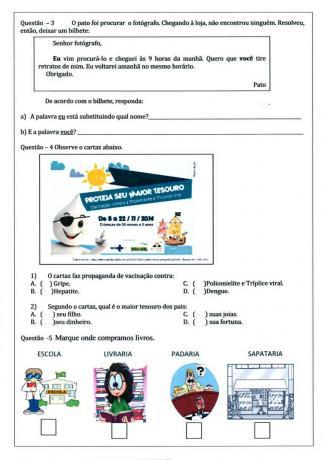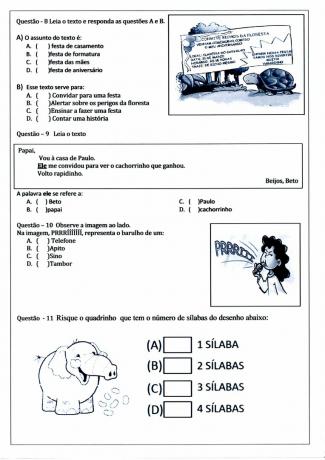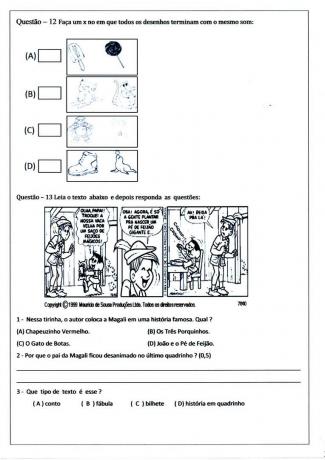We selected in this post 3 year diagnostic evaluation ready to print and available for download in PDF.
Is pedagogical assessment and non-punitive, which goes beyond the classic test, whose objective is to count hits and misses, as defined by Yves de la Taille, professor at the Institute of Psychology at the University of Saint Paul. With diagnostic evaluation, the teacher must be able to arrive at the matrix of error or success, interpreting the student's production.
According to the diagnostic evaluation, the teacher needs to find, at a given moment, in which stage of the process of construction of the knowledge lies the student and then identify the pedagogical interventions that are necessary to stimulate their progress. This diagnosis, which assesses the quality of error or success, allows the teacher to adapt their teaching strategies to the needs of each student.
The idea of diagnostic evaluation arose from the abolition of repetition in elementary education in public schools, with the so-called continued progression, implemented based on the recommendations contained in the Law of Guidelines and Bases (LDB) of 1996.
See too:
Index
Material prepared by the Regional Superintendence of Education of Leopoldina - Educational Board:
Material prepared by the Regional Superintendence of Education of Leopoldina - Educational Board:
Check out this suggestion for a 3rd year Portuguese Language Diagnostic Assessment to print:
See also:
Assessment to be used in the 3rd years of Elementary School, ready to print.





Also check: Form for initial diagnosis of the class
Produced by the state of Minas Gerais, the assessments below contain the descriptors and provide an overview of students' difficulties.
In addition to being considered a non-punitive analysis, which is not limited to classification levels, this method of assessment allows the school to constantly identify the causes of students' difficulties and organize new methodologies and specific pedagogical interventions that promote the dissolution of those doubts or perceived difficulties.
In other words, it allows you to repair which lesson formats or which types of activities were effective and which ones were not well received by students. Furthermore, its relevance is also in the fact that, unlike meaningless numbers, their results generate the updating of the way of teaching, bringing news to the educational context institutional.
With diagnostic evaluation, it is often possible to observe the students' need for innovation, but it still faces implementation resistance in school spaces.
The result is a more active participation of students, who start to deal with other forms of assessment, generating a greater level of use of the different knowledge acquired. Reflecting in the long term better results in entrance exams and national exams, due to the deep fixation of the classes.
In order to carry out the diagnostic evaluation, it is important that it is included in the pedagogical planning of the school as a whole. This is because this assessment should not be restricted to the beginning of teaching activities, as its objective is to analyze the learning process. Ideally, it should be at the beginning, middle and end of the year.
At the beginning of the school year, this assessment allows us to observe which points were not well assimilated in relation to the contents of the previous year, thus creating a starting point for teachers to carry out the necessary actions of correction.
In the evaluations in the middle of the annual activities, they act as instruments to analyze whether the planning made by the professor is bringing the expected results, also allowing for some aspects to be readjusted, if necessary.
At the end of the year, in addition to demonstrating the results of the school year in relation to the students, it provides an assessment of the adaptive posture of the teachers in relation to the pedagogical sensitivity to share knowledge taking into account the difficulties demonstrated by the students.
See now ways to promote this ongoing assessment:
Much knowledge can be demonstrated in classroom debates, while encouraging a good relationship with the different existing opinions.
Students, encouraged to talk about what they know, demonstrate points assimilated at school in contrast with their experiences and information obtained from the media, social networks and even conversations with their families and friends.
The production of texts can be used in different disciplines. In Portuguese, it is possible to assess from the capacity for cohesion and coherence, to discursive, grammatical and punctuation aspects.
The texts can also serve to summarize the content learned in the previous two months, allowing teachers to identify which points were absorbed and in what form.
Brief sketches, in addition to being fun, are evaluative forms that promote the development of the students' expression and posture. They can address specific themes of history or even be good allies for evaluation in foreign lyrics, with musical interpretation, for example.
The creation of mathematical problems, involving several equations and accounts, are good options for working the exact contents. In addition, with well-elaborated and contextualized problems, referring to other subjects, the student is already being prepared for national exams and entrance exams. With information from the site: http://blog.qmagico.com.br)
Subscribe to our email list and receive interesting information and updates in your email inbox
Thanks for signing up.

